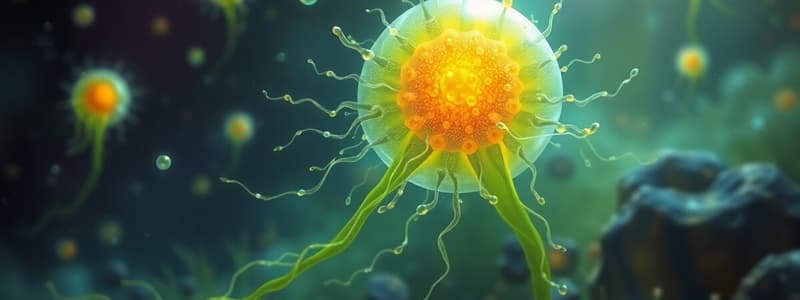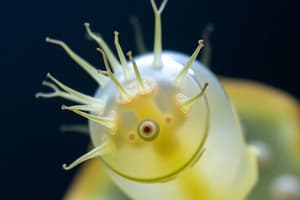Podcast
Questions and Answers
What defines protists as eukaryotic organisms?
What defines protists as eukaryotic organisms?
- Presence of a nucleus (correct)
- Presence of a cell wall
- Absence of a nucleus
- Lack of membrane-bound organelles
Which of the following characteristics is true for protozoans?
Which of the following characteristics is true for protozoans?
- They are multicellular
- They are prokaryotic
- They do not have a nucleus
- They are heterotrophic (correct)
What method do sarcodinians use to move?
What method do sarcodinians use to move?
- Spore formation
- Cilia
- Flagella
- Pseudopodia (correct)
Which of the following is an example of a zooflagellate?
Which of the following is an example of a zooflagellate?
What distinguishes ciliates from other protozoans?
What distinguishes ciliates from other protozoans?
Sporozoans are characterized by which of the following traits?
Sporozoans are characterized by which of the following traits?
Which of the following is a characteristic of all protists?
Which of the following is a characteristic of all protists?
Which group of protozoans is the largest?
Which group of protozoans is the largest?
What distinguishes heterotrophic protists from autotrophic protists?
What distinguishes heterotrophic protists from autotrophic protists?
The organism Plasmodium is an example of which type of protozoan?
The organism Plasmodium is an example of which type of protozoan?
Study Notes
Protists
- Protists are eukaryotic, meaning they have a nucleus
- Protists are neither plants nor animals
- They are unicellular organisms
- They are categorized into four "Supergroups"
- Protists can be heterotrophs, autotrophs, or decomposers
Protozoans (animal-like Protists)
- Protozoans are unicellular and eukaryotic
- Protozoans are heterotrophic
- They are motile
- Sarcodinians move using pseudopods, which are extensions of their cytoplasm. An example is amoeba
- Zooflagellates propel themselves using flagella, which are whip-like structures. Trypanosoma, which causes African Sleeping Sickness, is a zooflagellate that lives in tsetse flies
- Ciliates are the largest group of protozoans. They have hair-like cilia that cover their bodies. An example is Paramecium
- Sporozoans are parasitic protozoans that do not move. They reproduce both sexually and asexually. An example is Plasmodium, which causes malaria
Studying That Suits You
Use AI to generate personalized quizzes and flashcards to suit your learning preferences.
Related Documents
Description
Explore the fascinating world of protists and protozoans in this quiz. Learn about their classification, characteristics, and types, including heterotrophs and autotrophs. Test your knowledge on the unique features of these eukaryotic unicellular organisms.




